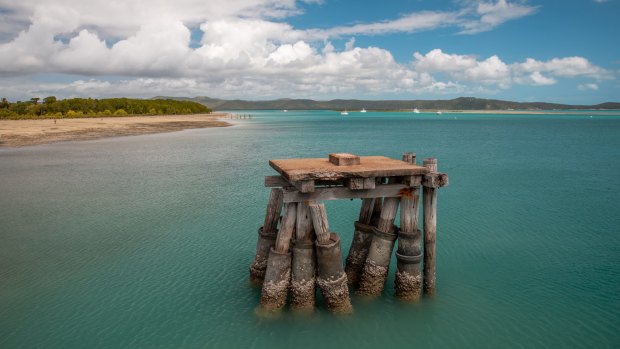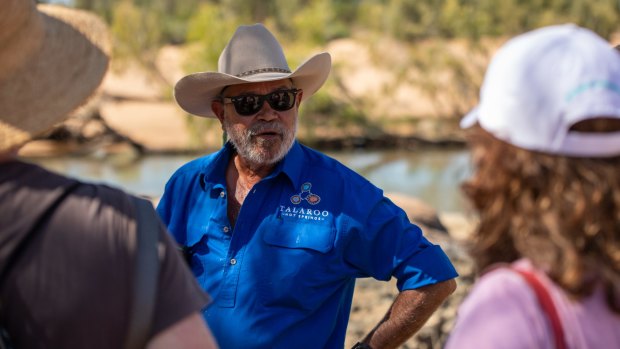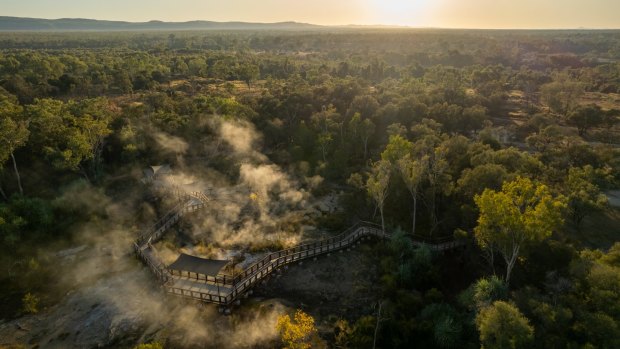This was published 1 year ago
Torres Strait Islands tours: Remote spot now easier to reach

The aquamarine waters of Torres Strait.Credit: phlipvids/Tourism and Events Queensland
I've always wanted to visit the Torres Strait Islands; that group of stepping-stones scattered between the tip of Queensland's Cape York and Papua New Guinea. Formed when sea levels rose about 8000 years ago they are the drowned remnants of a land bridge that once linked Asia with Australia. A remote and faraway place, of coral reefs and white beaches, where volcanic peaks jut above aquamarine waters and palm trees clutch at the sky.
But I'm not here for the scenery. I'm here to learn about a sea-faring people of Melanesian descent, whose rich and varied culture is closely tied to the stars. Whose knowledge of astronomy, seasonal winds and complex lunar phases allows them to navigate by the night sky, to know when to hunt turtle and dugong, when to plant and when to fish. A group of Indigenous Australians, culturally distinct to Aboriginal peoples.
Despite considering myself well-travelled (and being of Aboriginal descent) I knew less about Torres Strait Islander people than I did the moon. In the past, a few travellers have arrived solo by plane, others by ferry after the long and dusty drive to the tip of Queensland, and some by expedition cruise ship.

Jimmy "JR" Richards, Ewamian Elder, guide and cultural advisor.Credit: phlipvids/Tourism and Events Queensland
It has now become a bit easier to visit with the launch of a new day-tour being run by Strait Experience. Co-founded by Fraser Nai, a Traditional Owner from Masig Island, the 11-hour tour departs Cairns on a charter flight, visiting both Horn and Thursday islands. I'm on the inaugural day tour and excitement is high.
Two hours after departing Cairns airport our Dash 8-100 touches down on Horn Island, a fluffy green mat in a sea of blue. One of 247 islands in the archipelago, of which only 17 are inhabited, this rugged little island is known as Ngurapai to the Kaurareg people.
Within minutes we are immersed in a little-known chapter of Australia's military history on a World War II tour with local historian and guide Vanessa Seekee. From the Torres Strait Heritage Museum we travel by minibus and on foot to uncover some of the relics strewn across the island.

Talaroo Hot Springs.Credit: phlipvids/Tourism and Events Queensland
"Horn Island was the second hardest hit base in Australia after Darwin," Vanessa explains, as we trek through the forest to see the scattered remains of a crashed B-17 bomber. "During the war, Horn airstrip was an Advanced Operational Air base."
We learn that almost every single Torres Strait Islander man of eligible age – 880 in total – volunteered, forming Australia's only Indigenous battalion. "Only 10 men stayed behind to support their communities," says Seekee.
From Horn Island it's a spectacular 15-minute ferry ride to Thursday (Waiben) Island, the administrative capital of the Torres Straits.
"Our people have existed here since time immemorial," says Uncle Milton Savage during his welcome to Country address in the garden of the Gab Titui Cultural Centre. " It is a privilege and honour to share our culture with you, our stories, our history, and the history of past injustices."
The welcome dance starts with the rhythmic thump of the warup drum. Low and powerful, it echoes across the sandy stage. Soon the thump is joined by the rattle of kulap shakers, men's voices rise and fall as three dancers tell the story of the winter winds. While some dances are about totem animals and others reflect the pearl lugger days, all highlight the Torres Strait Islanders' deep connection to the land, sea and sky.
"The dances of today use knowledge from the past incorporated into our future," says Joey Laifoo, a Badu Island Traditional Owner dedicated to preserving Ailan Kastom (island custom). "If we share our stories then our culture stays alive."
After a traditional island-style feast we join the affable Dirk Laifoo of Torres Strait Eco Adventures for a minivan tour to catch some of the sites we might otherwise miss. Alongside the pub, post office and Green Hill Fort, which was built in the late 1800s as a defence against a Russian invasion, Dirk points out the local sports field, where the Saturday rugby league match is well underway. As Dirk explains, in the Torres Straits, footy is religion.
We also stop at the grave of Bernard Namok, the man who designed the Torres Strait Islander flag, and the courthouse where the late Eddie Koiki Mabo began his 10-year journey to overturn ''terra nullius'' in Australia's high court, which ultimately paved the way for Native Title claims (see straitexperience.com.au).
In the heart of Gulf Savannah country, 360 kilometres west of Cairns, Native Title Determination has allowed the Ewamian people to develop Talaroo Hot Springs (opened August 2021), an Indigenous-owned cultural tourism venture. While the sign out front is brand new, the geothermal system it represents is millions of years old. Unlike anything else in Australia, these series of geothermal pools and terraces are fed by water that has seeped through hot granite rocks, kilometres below the earth.
"This place is very significant to our people, " says Jimmy "JR" Richards, Ewamian Elder, guide and cultural advisor. "It's where our women went to give birth. It's a place of great healing."
With traditional lands back in Ewamian hands the country is also healing, after decades as a cattle station. "The earth is our mother, the rivers are our blood," says Jimmy. " We must look after our heartbeat."
As we walk along the Einasleigh River Jimmy points out stone groovings carved into rocks by his ancestors and flowering plants that indicate when it's time to burn.
"Our ultimate goal is to bring our people home, especially our kids," says Jimmy. "And what better way than through employment and training."
Visitor experiences include a 90-minute hot springs discovery tour, private soaking pools, a nightly yarning circle and stargazing. Talaroo hosts glamping tents, powered and unpowered sites, a modern camp kitchen, cafe and gift shop. After a late afternoon soak I sit on the verandah of my tent, watching the red sun on the savannah, a symphony of light to stir the soul (see talaroo.com.au).
Cairns is best known as the stepping off point to the Great Barrier Reef, but on the other side of Trinity Inlet (10 minutes by boat) the Mandingalbay Yidinji people offer an alternative experience.
Leaving Cairns behind we glide into Hills Creek, where sea water meets fresh water from the rainforest-clad mountains. Engulfed by mist and smoke from the welcome ceremony , it feels like crossing a secret portal to another time.
"Our people are descendants of the great warrior Jabulum Mandingalpai," says Elder Victor Bulmer, showing us a faded black and white image of the proud leader, famous for wearing a human femur through his nose and the umbilical cord of his first son around his neck.
The Mandingalbay warrior reputation is reflected in their clan totem, the black scorpion – Djunbunji – which is used today as the symbol for the Djunbunji Land and Sea Program, an initiative to look after country by traditional methods.
With a brand new, purpose-built 42-passenger boat, pontoon and visitor shelter, the 100 per cent Aboriginal-owned Mandingalbay Ancient Indigenous Tours is set to offer regular departures on their half-day, Hands-on Country eco tour.
"It is in Jabulum's honour that we continue to protect our country, our sacred sites and our totemic plants and animals," says Bulmer (see mandingalbay.com.au).
FIVE OTHER INDIGENOUS EXPERIENCES NEAR CAIRNS
DREAMTIME DIVE AND SNORKEL
Visit the Great Barrier Reef accompanied by Indigenous Sea Rangers on a full-day tour. See dreamtimedive.com
DEADLY AFTER DARK
Sip cocktails and dine on Thai-style kangaroo or mud crab under towering melaleuca trees. See mandingalbay.com.au
CAIRNS INDIGENOUS ART FAIR
An annual, week-long event that celebrates Aboriginal and Torres Strait Islander art and culture. See ciaf.com.au
WALKABOUT CULTURAL ADVENTURES
Learn about bushtucker, cultural practices and the history of the Kuku Yalanji people of the Daintree Rainforest. See walkaboutadventures.com.au
PAMAGIRRI ABORIGINAL EXPERIENCE
Enjoy a cultural dance at Rainforestation Nature Park near Kuranda, followed by a Dreamtime walk. See rainforest.com.au
THE DETAILS
TOUR
A Strait Day, the new tour by Strait Experience, runs on the first Saturday of each month ex Cairns and costs $1399 per person. See strait experience.com.au
STAY
On the esplanade in Cairns, the five-star Crystalbrook Flynn offers city-view room from $325. See crystalbrookcollection.com
MORE
Kerry van der Jagt travelled as a guest of Tourism and Events Queensland.
Sign up for the Traveller Deals newsletter
Get exclusive travel deals delivered straight to your inbox. Sign up now.